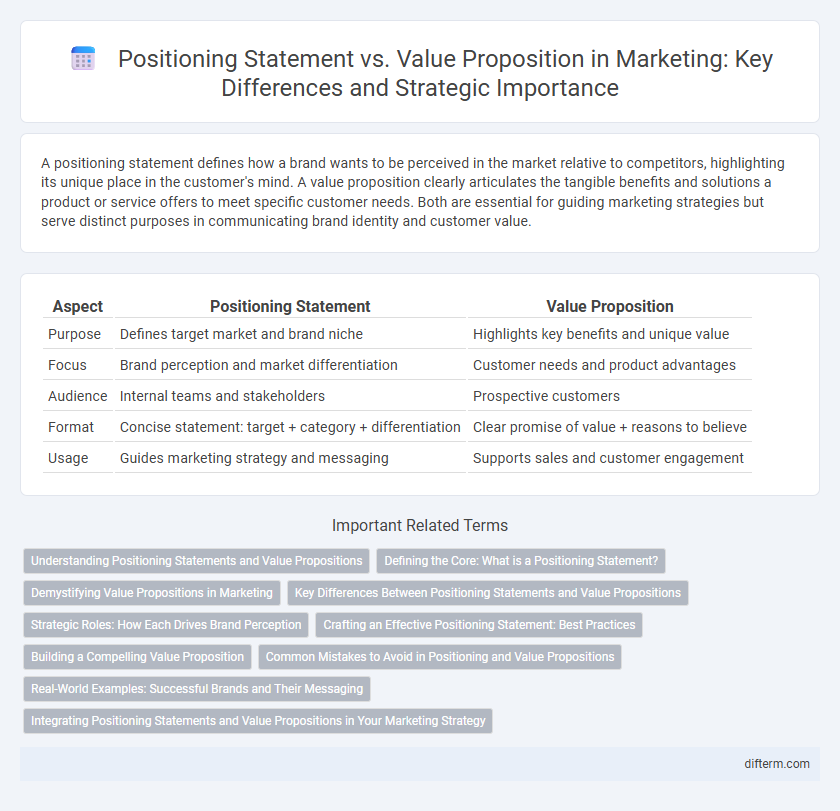A positioning statement defines how a brand wants to be perceived in the market relative to competitors, highlighting its unique place in the customer's mind. A value proposition clearly articulates the tangible benefits and solutions a product or service offers to meet specific customer needs. Both are essential for guiding marketing strategies but serve distinct purposes in communicating brand identity and customer value.
Table of Comparison
| Aspect | Positioning Statement | Value Proposition |
|---|---|---|
| Purpose | Defines target market and brand niche | Highlights key benefits and unique value |
| Focus | Brand perception and market differentiation | Customer needs and product advantages |
| Audience | Internal teams and stakeholders | Prospective customers |
| Format | Concise statement: target + category + differentiation | Clear promise of value + reasons to believe |
| Usage | Guides marketing strategy and messaging | Supports sales and customer engagement |
Understanding Positioning Statements and Value Propositions
Positioning statements define how a brand wants to be perceived in the minds of target customers, emphasizing unique market space and competitive advantage. Value propositions focus on clearly articulating the specific benefits and value a product or service delivers to address customer needs and pain points. Understanding the distinction helps marketers craft messaging that effectively communicates both brand identity and customer-centric solutions.
Defining the Core: What is a Positioning Statement?
A positioning statement defines the core identity of a brand by clearly articulating the target audience, market category, and the unique benefit that sets the brand apart from competitors. Unlike a value proposition, which emphasizes specific customer benefits and solutions, the positioning statement serves as an internal guide for marketing strategies and brand messaging. This foundational statement ensures consistency in how the brand is perceived and communicated across all channels.
Demystifying Value Propositions in Marketing
A positioning statement defines how a brand wants to be perceived in the marketplace, highlighting its unique place among competitors. A value proposition clearly articulates the specific benefits and value a product or service delivers to customers, addressing their needs and pain points. Demystifying value propositions involves understanding their role in communicating tangible outcomes that drive customer decision-making and loyalty.
Key Differences Between Positioning Statements and Value Propositions
Positioning statements define a brand's unique place in the market by addressing the target audience, category, and differentiation, while value propositions focus on the specific benefits and solutions offered to customers. Positioning statements guide marketing strategy and brand messaging, establishing perception, whereas value propositions drive customer decision-making by highlighting value and outcomes. Key differences include the emphasis on market context in positioning and customer-centric benefits in value propositions.
Strategic Roles: How Each Drives Brand Perception
A positioning statement defines a brand's unique place in the market by clearly outlining the target audience, category, and key differentiators, shaping consumer perception strategically. In contrast, a value proposition articulates the specific benefits and value a brand delivers, directly influencing customer decision-making and loyalty. Together, they drive brand perception by aligning strategic messaging with customer expectations and competitive dynamics.
Crafting an Effective Positioning Statement: Best Practices
Crafting an effective positioning statement requires clarity, specificity, and alignment with target audience needs, emphasizing unique benefits and competitive differentiation in the marketing strategy. Best practices include focusing on the brand's core promise, addressing customer pain points, and maintaining consistency across messaging channels to enhance brand perception and market positioning. A well-defined positioning statement serves as the foundation for developing compelling value propositions and driving successful marketing campaigns.
Building a Compelling Value Proposition
A compelling value proposition clearly communicates the unique benefits and measurable outcomes a product or service delivers to customers, differentiating it from competitors. Unlike a positioning statement that defines market niche and target audience, the value proposition focuses on solving customer pain points with specific, tangible value. Crafting a value proposition involves highlighting key features, emotional appeal, and quantifiable advantages to drive customer engagement and conversion.
Common Mistakes to Avoid in Positioning and Value Propositions
Confusing positioning statements with value propositions leads to diluted messaging that fails to resonate with target audiences. Overly generic claims and lack of customer-centric language reduce the effectiveness of both, diminishing brand differentiation and perceived value. Avoid vague wording and ensure alignment with specific customer pain points to maximize marketing impact.
Real-World Examples: Successful Brands and Their Messaging
Nike's positioning statement emphasizes empowerment and athletic excellence, targeting serious athletes with "Just Do It," while its value proposition promises innovative, high-performance products that inspire confidence and achievement. Apple's positioning centers on simplicity and creativity for tech enthusiasts, whereas its value proposition highlights intuitive design, seamless integration, and premium user experience. Tesla positions itself around sustainability and cutting-edge technology, with a value proposition that combines electric performance, environmental responsibility, and luxury appeal.
Integrating Positioning Statements and Value Propositions in Your Marketing Strategy
Integrating positioning statements and value propositions in your marketing strategy ensures clear communication of your brand's unique benefits and target audience alignment. Positioning statements define the market niche and competitive landscape, while value propositions emphasize the specific customer benefits and solutions offered. Combining both elements creates a cohesive message that enhances brand differentiation and drives customer engagement.
Positioning statement vs value proposition Infographic

 difterm.com
difterm.com